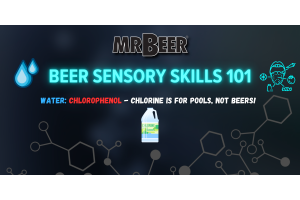3 Ways to Prevent Darkening Beer When Brewing with Extract
This is a question that we get quite often. People will brew their beers and it turns out darker than usual. So we wanted to talk about 3 ways to prevent darkening your beer when brewing with extract.
In a previous episode of BrewTalk, we talked about why brewing with malt extract makes your beer darker but now we wanted to talk about some reasons to help prevent darkening.
Malt extract, in particular liquid malt extract or LME, is known to create a darker finished beer because it is a concentrated product created through evaporation.
It allows for the brewer to skip the time- and attention- intensive processes of mashing and sparging, since these processes are completed to create extract.
A wort is made through mashing and sparging, then concentrated down to a thick syrup (for LME, powder for DME) by using an evaporator and vacuum pressure to remove the moisture. This process causes the wort to darken slightly and can result in darker beer than normal.
All Mr. Beer’s extracts are made by Coopers Brewery out of Australia. They are the worlds biggest producer of malt extract for homebrewing and they create the highest quality malt extract with their state-of-the-art low-temperature evaporator. They control the entire brewing process from the grains grown in the field to the malting of the grains and then brewing. The same malt extract in your can comes from the same wort that the brewery uses to brew their beer for commercial distribution.
1. Do Not Caramelize Partially-Dissolved Malt Extract
As you pour liquid malt extract into hot water, it does not dissolve evenly or instantly. It instead needs to be stirred to combine with the water because it is thick like molasses. Small, caramelly blobs of the extract can remain, even after attentive stirring. If the bottom of the pot your brewing in is hot, those small blobs can caramelize onto the bottom of the pot. Scorching extract onto the bottom of the pot is sure to darken the wort. To avoid darkening your extract brew, be sure to turn off the heat before stirring extract into the water. You will want to stir until you no longer see small partially-dissolved blobs of extract in your wort, then continue to stir for about a minute for good measure.
2. Do a Partial Mash or Steep using DME
Dry malt extract undergoes similar processes to liquid malt extract, however, even more water is removed, allowing it to stay fresher and store longer. Brewing with dry malt extract also provides a lighter finished beer than brewing with liquid malt extract. Many brewers choose to use DME to steep their grains in or do hop boils before adding their LME. This helps keep the color lighter. Boiling with LME will cause your beer to be dark, DME does not.
3. Be Sure Your Extract is Fresh
Fresh and properly-stored liquid malt extract is crucial for achieving a lighter finished beer. The older liquid malt extract gets, and the more it is exposed to heat/warmth, the darker the melanoidins in the extract become. If you want to be confident that your beer will stay on the lighter end of the spectrum, you'll want to be sure the Best By date on your extract is far off and you are storing it in proper conditions. Though even with all of these smart tips at your disposal, it's important to remember that lightening your beer will not make it any more flavorful or refreshing. It's a greater priority to choose the right extract for the style of beer you wish to brew than for the color you believe it should have.





